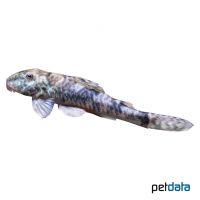Pitbull Pleco (Parotocinclus jumbo)
| Pitbull Pleco Parotocinclus jumbo | |
|---|---|
| Name | Pitbull Pleco |
| Name Lat. | Parotocinclus jumbo |
| Synonym | LDA25 |
| Family | Suckermouth Armoured Catfishes |
| Family lat. | Loricariidae |
| Order | Catfishes |
| Order lat. | Siluriformes |
| Origin | Brazil |
| Habitat | Streams |
| Diet | Limnivore, aufwuchs |
| pH | 5.5-7.5 |
| Behavior | Peaceful |
| Keeping | Group |
| Care Level | Moderate |
| Reproduction | Substrate spawner |
| Breeding | Difficult |
| Life Span | 4-5 years |
| Protection | No |
| Metric Units | |
| Size | 6 cm |
| Temperature | 22-26 °C |
| Hardness | 5-15 °dH |
| Aquarium | ~ 80 l |
| US Units | |
| Size | 2.4" |
| Temperature | 72-79 °F |
| Hardness | 89-267 ppm |
| Aquarium | ~ 20 gal |
Distribution and habitat
Spotted ear catfish are widely distributed in the waters of eastern Brazil. They live in streams and small rivers, with dense riparian vegetation, among dead wood and aquatic plants.
Maintenance
The aquarium should have dense planting with stones and roots that provide hiding places. A sandy substrate covered with some foliage (e.g. sea almond leaves), subdued light (floating plants) and a weak current is ideal.
No ammonia, ammonium and nitrite should be detectable, the nitrate value should not exceed 100 mg/l. To ensure the water quality and oxygen content, a filter and heater adapted to the aquarium size is required, as well as lighting for the species-appropriate day-night rhythm of the animals.
Diet
They eat the vegetable cover (growth) of stones, wood, plants, etc. and the microorganisms contained therein. For a balanced diet, feed once a day with a high-quality dry food for catfish (granules, pellets, chips, tablets), supplemented with algae leaves, fresh vegetables, such as zucchini, broccoli, bruised peas or scalded spinach, plus occasional small amounts of zooplankton, cyclops, daphnia, artemia, mosquito larvae, etc. (live or frozen)
Feed only as much as will be eaten within a few minutes, excluding plant foods. Regular and varied feeding promotes health and increases resistance.
Behaviour and compatibility
These very peaceful, diurnal catfish live in groups or small schools and can be kept well in a community tank with other small and peaceful fish as well as shrimp and dwarf prawns. They should be kept in a group of at least 5-10 fish
Basically, only compatible fish species with similar requirements for water conditions and water temperature should be socialized.
Sex dimorphism
The sexes are difficult to distinguish. Males have longer pectoral fins, females are slightly larger and more rounded.
Reproduction and breeding
The spawn is attached to plants, panes or other substrate. The larvae hatch after 2-3 days and swim freely after 4-5 days. The parents do not engage in brood care.
Juveniles must be fed several times a day with special rearing food (infusoria). In community tanks breeding is hardly possible, because the spawn is easy prey.
Important
They are considered good algae cleaners and aquarium plants are hardly damaged.
The foliage (sea almond tree, oak, etc.) enriches the water with humic substances, naturally lowers the pH and is a valuable secondary food source (dietary fiber).
When fishing, use as fine-meshed nets as possible so that the hard rays of the pectoral fins do not become entangled.
The well-being of the fish should be checked regularly. Temperature should be checked daily, pH, hardness and nitrate levels at least every 14 days. Regular partial water changes are recommended, even if the contaminant level has not yet reached the upper limit. Sudden changes in water quality should be avoided. Newly introduced fish must be accustomed slowly to the water in the aquarium.
Further literature can be found in your pet store.
References
Text: petdata; Image: petdata
Source: BMELV (1998): Tierschutzgutachten - Haltung von Zierfischen (Süßwasser); BAENSCH & RIEHL (1997): Aquarien Atlas Bd. 5, Mergus Verlag; ENGELMANN (2005): Zootierhaltung - Tiere in menschlicher Obhut: Fische, Verlag Harri Deutsch
- Gemäß § 21 Abs. 5 Tierschutzgesetz idgF
